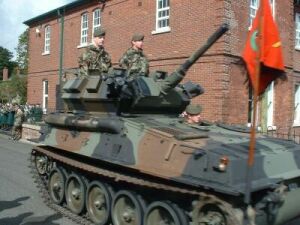|
The Curragh
|
History - Information - Contacts |
|
|||
The Curragh's
"Armoured Steeds"
by Bob Webster
|
The history of the tank in service with the
Defence Forces goes back to the late 1920s when the government
of the day agreed to the purchase of a Vickers Medium tank. Designated
‘Mk.D’, this tank was a development of the ‘Mk.2’, which had been
produced from the mid 1920s onward, 150 of which were supplied to the British
army up to the mid 1930s. Vickers-Armstrong Limited were probably the foremost
tank building company in the world in the inter-war years and many of their
designs and products were exported throughout the globe. |
|
|
The Army’s Mk.D’ was completed in 1929,
with Lt. Sean Collins-Powell, nephew of the late General Michael Collins and a
future GOC, Curragh, being sent to England to carry out driving trials and to
take delivery. A small tank cadre was formed at the Curragh to look after the
Vickers and to demonstrate its potential to other army units. |
|
|
The Vickers Mk.D’ was joined in 1935-36 by
two Landsverk L-60 tanks. Developed and built in Sweden by a company very much
involved in commercial armoured vehicle production, the L-60 was regarded as |
|
|
Attached to the Cavalry School, the three tanks
continued to be used for demonstrations and training purposes at the Curragh up
to 1939-40. Unfortunately, at this stage, the Vickers was ~fata11y’ damaged
but the L-60s continued in use. A special Landsverk self-steering trailer had
been delivered earlier for ‘long-distance’ transport purposes and this was
presumably used when a decision was taken to take a tank to each army unit
throughout the country in order to assist with anti-tank training. The L-60s
were subsequently retained by the Cavalry Corps into the 1950s, although little used in later years. |
|
|
|
In 1948-49, following an earlier successful
training stint in England by several Cavalry Corps officers, four Churchill
infantry tanks were leased from the British War Office and delivered to the
Curragh. The Churchill had been designed by Vauxhall Motors Limited in the early
years of World War Two, using an earlier somewhat unsatisfactory design for
reference purposes and was powered by a new ‘flat 12’ engine with two
horizontally opposed banks of six cylinders. The original tank had been
constantly revised and improved during the course of the war. |
|
Initially, the Churchills were driven to the
Glen of Imaal twice a year for gunnery training and demonstration, but
complaints from Kildare and Wicklow County Councils about the damage being done
to the public roads led to the purchase of a World War Two ~Diamond T’ tank
transporter in 1950. American in origin, this truck trailer
combination was regarded as the best available through the 1940s and 1 950s and
some even continue to work today throughout Europe as recovery vehicles. The
Churchill’s were purchased outright after five years and continued in service
up to the late 1960s having been joined some years previously by a further World
War Two type, the Comet. |
|
|
The Comet which first appeared in 1944 was
designed as a ‘cruiser~ type tank, unlike the Churchill, but again was
developed from an earlier design. It was powered by a version of the famous 12
cylinder Rolls-Royce ‘Merlin’ aero engine, as used in the Spitfire, and was
capable of reaching circa 30 m.p.h. Four Tanks were purchased in late 1958 and a
further four arrived in early 1960. Again these vehicles, like the
Churchill’s, were used for training and demonstration purposes both in the
Curragh and the Glen of Imaal through the 1960s and early 1970s. |
|
|
One incident
(memorable for the wrong reasons), took place in 1961 when the faithful
‘Diamond T’ with a Comet loaded on its modified trailer left the road in the
Gormanstown area
between Kilcullen and Dunlavin and overturned, necessitating a week-long
recovery operation by Base Workshop personnel. |
|
 * * |
Finally, a decision was taken in the late I 970s
to replace the now unserviceable Churchill’s and Comets with the Scorpion
CVR(T) reconnaissance’ tank. Designed and built in England by Alvis Limited,
the Scorpion is one of a family of military vehicles placed in service with the
British army in the 1970s and subsequently exported to many other countries.
Twelve such vehicles were purchased by the Irish authorities in the early I 980s
and continue in service today. |
|
* |
|